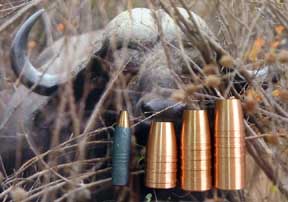

 The Accurate Reloading Forums
The Accurate Reloading Forums  THE ACCURATE RELOADING.COM FORUMS
THE ACCURATE RELOADING.COM FORUMS  Rifles
Rifles  Big Bores
Big Bores  Really big stuff - 8 bore
Really big stuff - 8 boreGo  | New  | Find  | Notify  | Tools  | Reply  |  |
| One of Us |
My buddy just picked up a really nice 8 bore and a 10 bore pinfire double rifles....Now the fun stuff. I am looking for bullet molds for both and loading dies and brass for them so that I can load shells and take these bad boys to the range. The 8 Bore looks to have an 3 1/2" chamber and I have been informed that 8ga plastic cases can be used if slightly modified. I would appreciate any information as to where I can obtain molds for either caliber and dies for both. Would 8ga brass resizing dies for shotshells work? Thanks, Craig | ||
|
| one of us |
Craig_ Glad your visiting posting here. Fellas, Craig has a 14.5mm Russian rig he plays with also. You can get new 8bore plastic industrial cases from BPI and turn down the bextra belt layer to fit original 8ga chamber. They are as strong as brass cases. 70cents each and 3.3" long, primed. They also have the wadcups.,cards and roll crimper for drill press.. BPI also has the blunt cylinder like 3 oz lead slugs A bunch of 8ga guys in the UK use 8ga industrial cases rigged like that. For brass cases he'll have to get with Rocky Mtn Cartridge, but Dave is way behind being buried in orders.So you may wait awhile. I know of no other brass supply. The plastic cases easily have gotten over 8,000 ft lbs without resizing for 4-6 loads, in the NEF I bored out and my Enfield one.. With regular older gun you'have to load down so cases mat go 10 times. Good powder for 8ga is 4227 and better powder is the new RL-17. Both fire with shotgun primers, and you can use slow shotgun powders but I don't have loads for them. The RE-17 much better and safer. Best to use plastic to get started shooting and load work and set them aside after 5-10 rounds if they get expanded, and go to next case. Brass ones will be 12- 15 bucks each. If you could find dies for brass the plastic cases may resize ok with them. I plan on making a mold for a Lyman style, nose-heavy slug for 8 ga. Ed MZEE WA SIKU | |||
|
| One of Us |
Craig- I want to see photos of the 10-bore rifle. Did you get that via auction? I've taken quite a few high grade pinfire SxS guns and double rifles from 100+ years of sleep to fully running hunting rigs. Do chamber casts on the pinfire rifle, slug the bores (both of them, from breech and from muzzle) and post your numbers here to the discussion thread. I'm very much interested to hear and see more about what you have there. Cheers Tinker _________________________________ Self appointed Colonel, DRSS | |||
|
| One of Us |
Contact Roland Huber at 603 267 8227...He IS the 8 Bore GURU!....He loads for them,shoots them and sells componets,ammo,accs,etc....I have had several of them,like them alot.Please note that there are many variations of it as far as chamber and bore diamaters go,so be careful!..Tell Roland hi for me (Tom/Cheyenne) "That's not a knife..THIS is a KNIFE" ! | |||
|
| One of Us |
Thanks for the info Ed The bores in the 8 bore are 3.5" long and I obtained these measurements from the muzzle: 0.839" 0.831" Chamber: 0.919" chamber dia. 1.037" rim 0.115" rim thickness I don't have enough stuff to cast the chamber properly yet. As for the 10 bore pinfire.... At muzzle : 0.800" and 0.779" Do these sound close? I have been talking to CBE in Australia for moulds and they recommended a minie ball type bullet that was .837" and a similar one for the 10 bore at .785" @ ED - because the 8 ga plastic shot shells are 3 1/4" and the chamber measures 3 1/2" would they still be suitable? @ Tinker - My buddy got the doubles out of the UK at auction. My main computer is N/S so I don't have any pics at the moment. As soon as I get the measurements and pics I will post. I am also very keen on learning to reload pinfires (seems like a good challenge). Still looking to find sizing dies. My buddy found some brass cases but I would like the dies to seat bullets and put a crimp on them as well as resize the mouth to allow for a snug fit. | |||
|
| One of Us |
I think I saw that 10-bore in the auction catalog. If it's what I was looking at - he's likely got quite a nice rifle. We'll need to hear bore and groove of both barrels. Also it's going to be very helpful to see what the rifling profile is and what the twist rate is. Will be very helpful to see what the chambers look like too, as well as some good close photos of the standing breech in section (side shot) and a good shot of what the breech ends of the chambers look like. I suggest he start out with roundball for that ten bore pinfire rifle. Minie (open-skirted conicals) bullets won't likely work out, the roundball stands a great chance of working out. Jeff Tanner can set him up with a roundball mould machined to his specification for something like (less than) $50.00usd shipped. Have a mould made that throws ball a few thou oversize. Loading for the pinfire system isn't so tricky, once you have your tools together. I make my own dies, for some of the guns and rifles I've made the cartridge cases one-off from barstock, others I've gotten away with modifying existing cases. The (by the end of the process) cheapest way to go is to have Dave at Rocky Mountain Cartridge just make you some cases. Send him chamber castings, pay, and wait. Bullet sizing dies, case swaging and forming dies, reloading tools -- all are relatively simple and cam be turned out on any good lathe with good material. The last swaging/forming dies I made were cut out of Inconel stock, as it was what I had handy that was the right size for the job. Decent tool steel will work out fine. If you have a press that takes BMG dies like my big Lee Classic Cast press, you're good to go on the big-bore die size. I also have simple die sets that I can use in the field with a mallet or in a vice or press in the workshop. Once the tools are there, loading is as simple as dropping a percussion cap in there, setting it with a firing pin, dumping your black powder and setting it with over-powder card and a lubed felt wad, then seating your bullet and it's time to shoot! Get those chambers miked or cast, bores (bores/grooves) too, and include rifling profile and rate of twist. Can't wait to see detailed photos and information. Send your friend my best wishes on getting it going. I'm happy to share my two bits at any time in the process. Cheers Tinker
_________________________________ Self appointed Colonel, DRSS | |||
|
| one of us |
Yes the 3.3" plastic will work fine in a longer chamber, just like 2.75" 12ga case works ok in a 3.0" 12ga chamber. The plastic industrial case measures .915 at base with the belt layer turned off. If your doubles are older the loads will be loaded down so plastic should go until mouth wears out from crimping. The UK guys use them for shot mainly and have good luck. Great for birds they say..Ed MZEE WA SIKU | |||
|
| One of Us |
Thanks Guys for the info.... @ tinker... I contacted Roland and the ball is rolling... will keep you updated... Should also have picts up by the weekend. | |||
|
| One of Us |
Sounds great! I look forward to seeing the images and the numbers. Send your friend my congratulations on getting the rifles, and send him my moral support on his efforts to get the pinfire rifle running. Cheers Tinker _________________________________ Self appointed Colonel, DRSS | |||
|
| One of Us |
Some photos of my “new girls.”    John | |||
|
| One of Us |
The best thing about these two Double Rifles is the condition of the bores, they both have mint bores, this hardly seems possible on two very old black powder rifles.  I believe this is an example of Pope rifling, please correct me if I am mistaken, I am no expert on these large bores. She shows eleven groves, the lands have a different angle on each edge.  Again correct me if I am wrong, I believe this to be Metford rifling. I was not looking for a 10 bore, certainly not a pin fire, I was really intent on a .470 NE but this girl caught my eye and you know what they say, it was love at first sight. John | |||
|
| one of us |
missing something- did you get a '8 gauge' shotgun, or is it an '8 bore", like the old 4 bores and such? *We Band of 45-70er's* "Far better it is to dare mighty things, to win glorious triumphs even though checkered by failure, than to rank with those poor spirits who neither enjoy nor suffer much because they live in the gray twilight that knows neither victory nor defeat." -Theodore Roosevelt- | |||
|
| one of us |
john Hipwell- nice rifles! congrats! *We Band of 45-70er's* "Far better it is to dare mighty things, to win glorious triumphs even though checkered by failure, than to rank with those poor spirits who neither enjoy nor suffer much because they live in the gray twilight that knows neither victory nor defeat." -Theodore Roosevelt- | |||
|
| One of Us |
The rifles are actually Johns, I am just helping him out. There is a 8 bore double rifle and a 10 bore pinfire rifle. The "rifle" is an actual 8 bore rifle and not a shotgun. | |||
|
| One of Us |
MS, Do you know the maker and the weight of the 8 bore. | |||
|
| One of Us |
The 10 bore pin fire has 26 inch barrels and weights 12.8 lb. She has “THOMAS JACKSON. 29 EDWARD STREET PORTMAN SQUARE LONDON” on the top rib,and lock plate, see photo below.  The 8 bore has 26 inch barrels and weights 16.6 lb. She has “R0GERS ROCK & Co. LONDON” on the top rib and lock plate.  | |||
|
| One of Us |
Great rifles. That pinfire ten bore is glorious! As I noted on the other site, get both chambers cast on both rifles. Slug both bores of both rifles too, chamber end and muzzle end. Redundancy is a good thing with this kind of work. Compare the castings from each barrel to be sure you don't have any chamber issues lurking in there, and when you've confirmed that all's good with the chambers - send one casting from each rifle to Dave at Rocky Mountain Cartridge and get in his schedule for ten or twenty pieces of brass for each rifle. Do that right away, don't delay. You won't miss the money, and while you wait for brass you can fiddle with plastic hulls or bullet moulds or ball moulds etc. On bullet and ball moulds -- In your bore-slugging exercise, get good slugs from the muzzles and from the chamber ends. Mark them. Compare chamber/muzzle to see if you have choke-boring, compare Right/Left to get a consensus on what your greatest bore size is. Run slugs from chamber through the bore out the muzzles and vice-versa to 'feel' for tight or loose spots, checking for (even slight) bulges in the bores that might not show externally (could have had those barrels refinished at any time in the last 100++ years) Take a look at these images.   I have quite a few more such images form catalogs and texts from the period of your rifles, but these three shapes pretty much cover what will end up working. Don't bother with minie bullets. I really don't think you'll end up doing well with open-skirt bullet-base shapes. From what I'm seeing here, you have pretty deep chambers and will be having relatively significant gas pressure (for all it's worth) at the muzzles. In this case, solid base is better than open-skirt. Really, I think you'd do best with hard roundball, and strongly suggest you have Jeff Tanner (from the UK) build you a couple of ball moulds that'll throw wheel-weight material at three to five thousandths over groove diameter for each rifle. Having slugs and casts from both bores of each rifle ensures that you'll be able to budget that number on the biggest groove diameter of each rifle. Good consistent gas seal is very important to proper and consistent powder burn. The metal-to-metal seal of proper ball-to-barrel fit is the best route to success. I have other little tricks that help with this too, and they also provide a very good bore wiping and lubricating action. 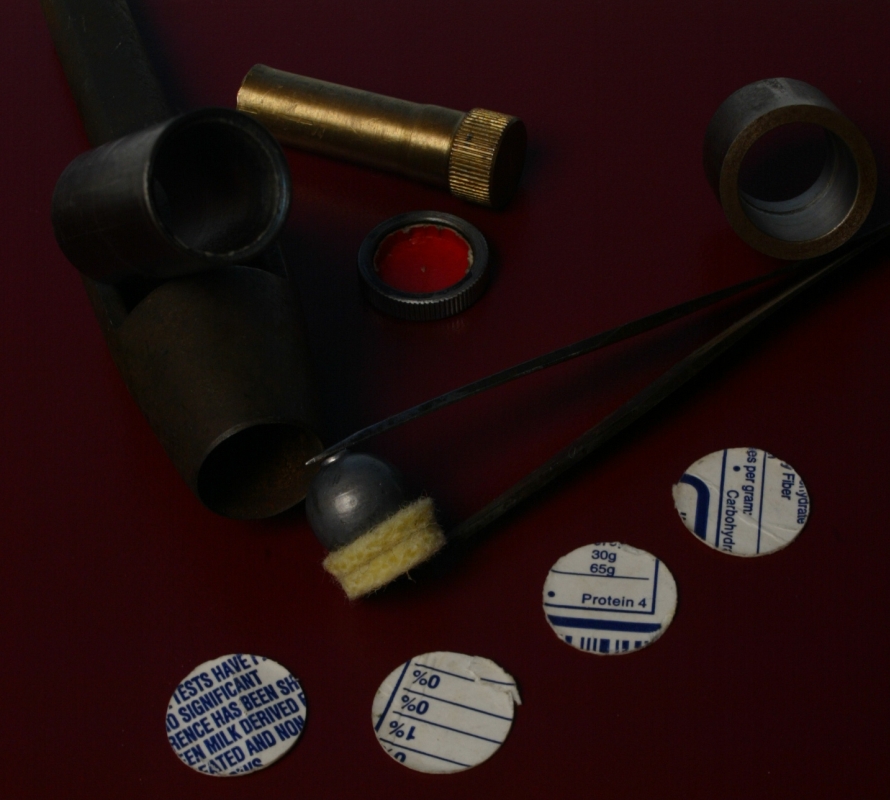 See the ball sitting on the lubricated wads, grasped in the tongs? That's two wads, one solid disc and one donut-shaped wad. The donut wad is directly under the ball, the pressure of combustion pushes it against the ball, expanding it against the bore. See the red disc wad in the steel ring? That's an over-powder card. The red cup side goes down on top of the powder. The pressure of combustion presses the 'skirt' of that card wad against the bore, helping with gas-seal. The steel tube sitting on the arch punch is the forming 'funnel die' for the card cups, also good for guiding the wads into the cartridge case. The steel tube sitting on the handle-end of the tongs is a simple crimp die. The end that's open to view is where the case mouth goes, the other end (see the stepped bore) is faced to length (from the bore-step) perfectly to allow the tip of a ball to be flush with that end of the die once the crimp is properly formed. Trimming it to length is easy, and I set that length to a proper charge of powder, a proper wad column, and the right amount of compression. I perform the crimp operation in any simple press or machine vise. I actually often use my graver's block for the crimp operation, as it's in the library adjacent to my loading room. 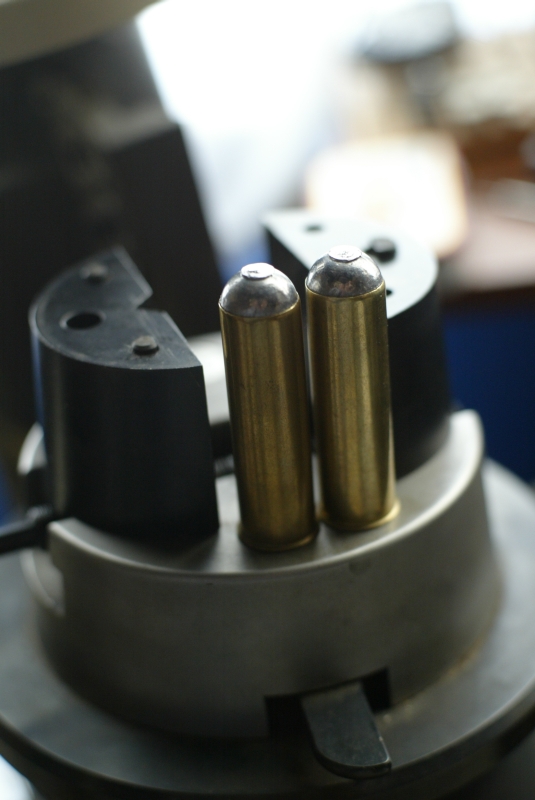 That is a couple of good-looking properly loaded pieces of bore-rifle ammunition. Also note the relative length of that piece of pin-fire ammunition pictured at the top of this list of images. See how it's *shorter* than the image of the 8-bore ammunition from the Greener book image and the sixteen bore cartridges seen directly above here? I'm guessing that when you get the chambers cast on that pinfire rifle (make sure to get the full rim thickness in your castings, let it mushroom over the barrel breeches just a bit) you'll notice that they've almost surely been lengthened at some time. Look very closely for a distinctly different surface finish (tooling marks) in the forward portion of those chambers. It was not uncommon in those days for the big game hunters to go back to the maker (or other gunbuilder) for a heavier charge and bigger chambers. There were makers who actually specialized in that kind of conversion. Any way it goes, start off with black powder (ffg at the finest, don't grab the fffg) and a healthy wad column and work your way up to a regulation charge. Add powder until the barrels shoot together. Add powder to bring the pair down to the sights. Stop when they begin to cross. When you get the chambers cast for that pinfire ten bore ping this thread with images and measurement numbers. We will be looking at some very critical (to the functional success to your cartridges) numbers: -pin diameter -case head thickness -rim diameter -rim thickness Also important in the grand scheme of your ignition system is pin angle and length. You want the firing pins to be completing the ignition process with the faces nearly parallel to the bore axis, and arresting before the heels hit the breech balls. Upon ignition, the pins should stand nearly perpendicular to the hammer faces at rest. This should be lots of fun for you, and I can easily see that ten bore rifle either becoming your favorite rifle or see you looking to pass it off to someone else to fiddle with... Cheers Tinker _________________________________ Self appointed Colonel, DRSS | |||
|
| One of Us |
8 Bore first: We did some measuring today and here is what we found. We did chamber casts on both right and left barrels. 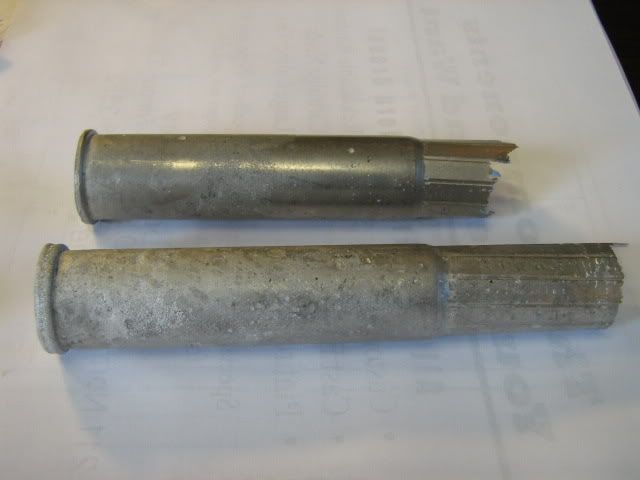 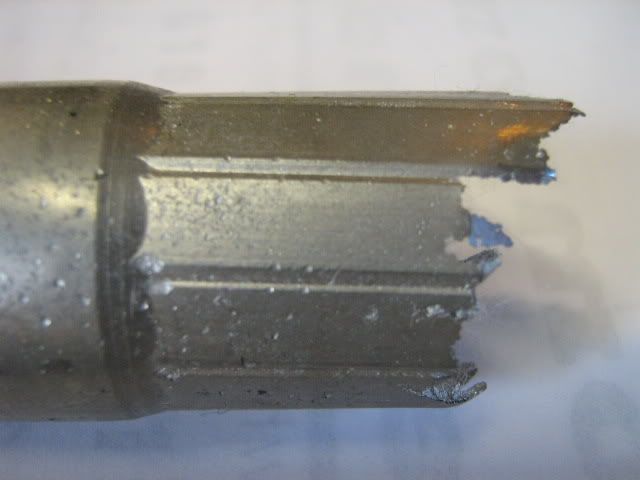 3.5" case length Rim appears to be thicker than normal. 0.115" thick. Barrels seem to have a 1/90" right hand twist. Right Barrel: The barrel lands and grooves measure 0.846" -0.847" Case (near mouth) 0.923" Case (at rim) 0.926" Slugged bore: 0.842" 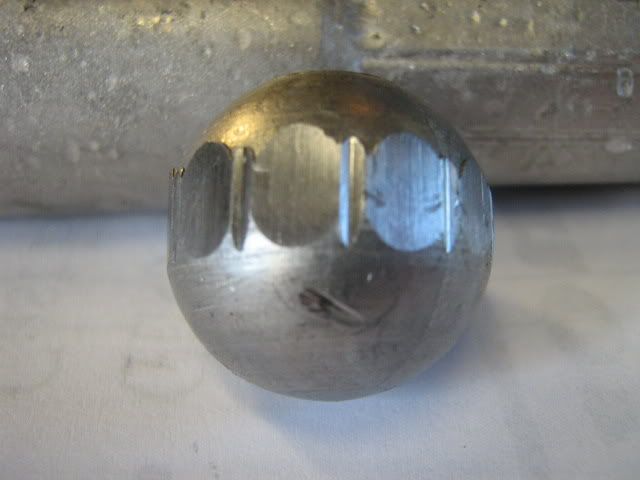 Left Barrel: The barrel lands and grooves measure 0.846" -0.851" Case (near mouth) 0.923" Case (at rim) 0.926" Slugged bore: 0.842" All measurements for both bores seem to be +- 0.003" The barrels weigh 9.0 lbs and the total weight of the rifle is 17.2 lbs. We loaded some Remington Industrial cases and with some Black powder we tried her out.... 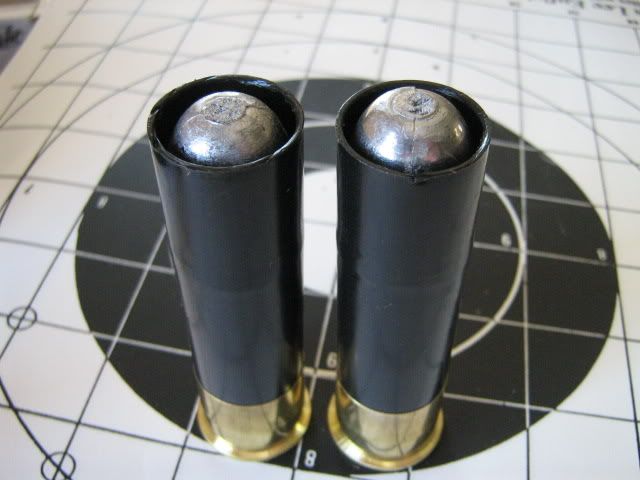  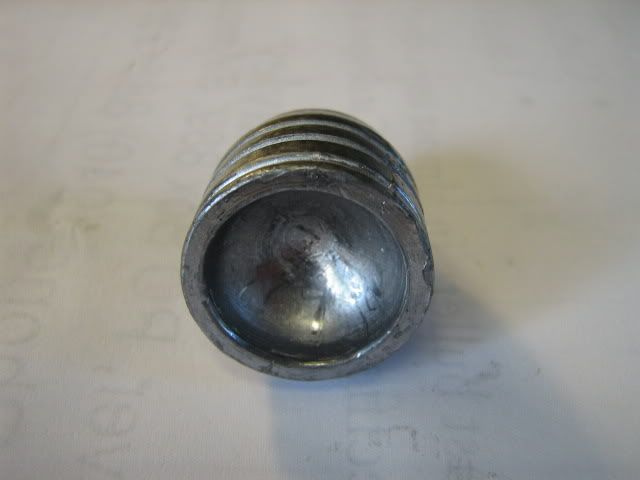 We used 247.5 grains (9 drams) of FFg and covered it with 1 - 1/2" wad and a 1/4" card wad and then sat the bullet directly on top. A 1025 grain hollow based round nose. (All I had to try). Got a velocity of 1413 fps. A second loading of 275 grains (10 drams) produced velocity of 1623 fps. No accuracy tests as of yet. More to follow on the 8 bore. | |||
|
| One of Us |
10 Bore pinfire Chamber casts: 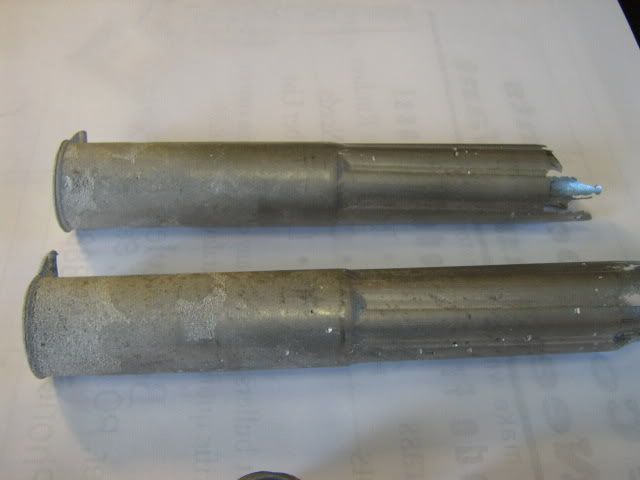 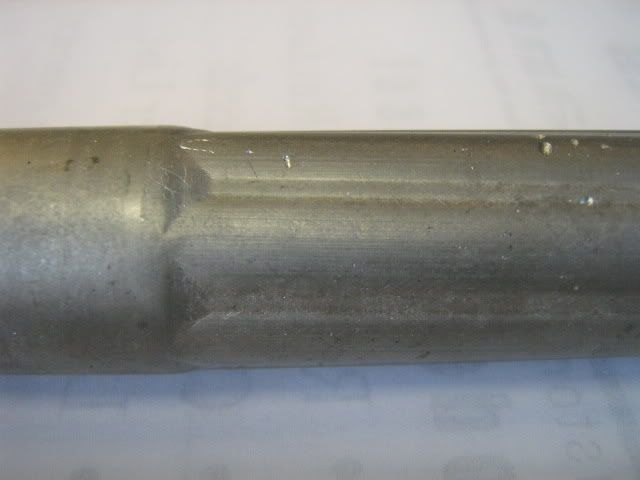 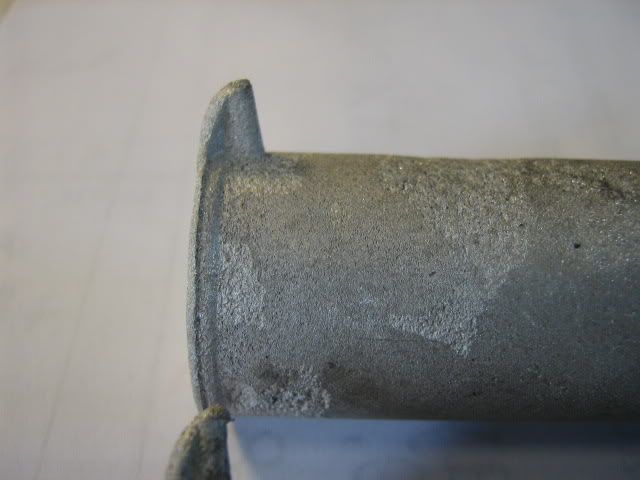 Barrels appear to have a 1/93" right hand twist. Case length 2.63" ( I got some 2 5/8" that seem to fit the bill) 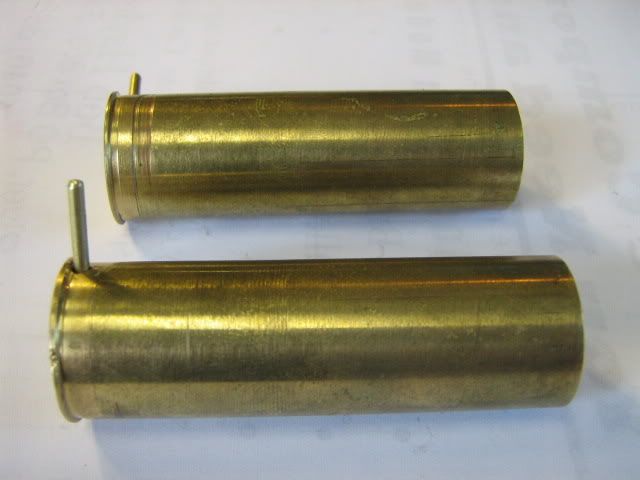 Left barrel: Base diameter 0.850" Case mouth: 0.846" Pin hole diameter: 0.099" Lands and groove diameter: 0.812" - 0.815" (chamber end) Lands and groove diameter: 0.795" - 0.800" (muzzle end) Right barrel: Base diameter 0.850" Case mouth: 0.846" Pin hole diameter: 0.099" Lands and groove diameter: 0.807" - 0.811" (chamber end) Lands and groove diameter: 0.795" - 0.799" (muzzle end) 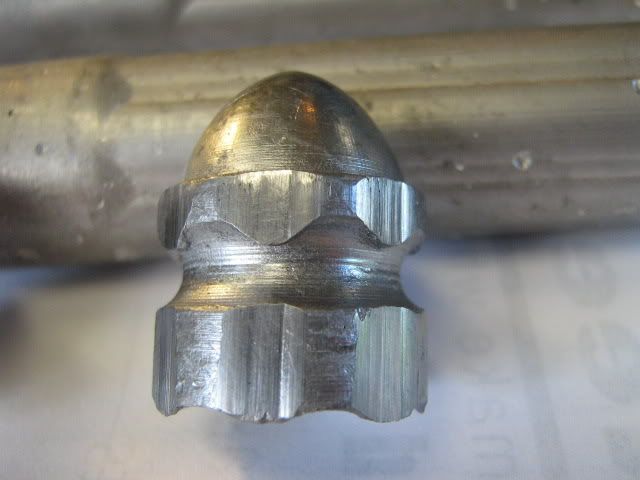 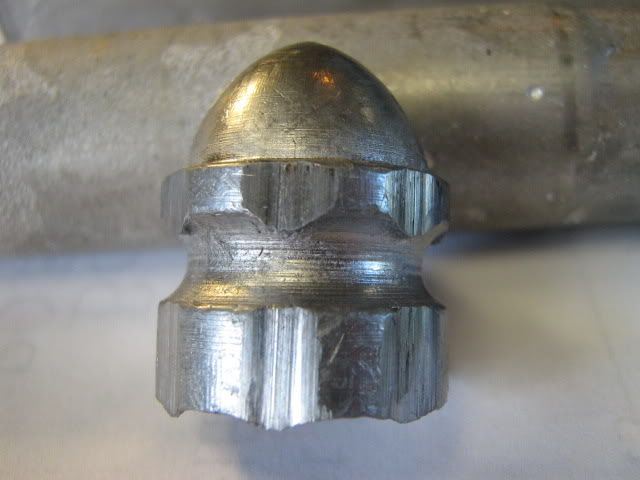 No shooting of this girl yet..... Barrels weigh 7.6 lbs and the gun weights 12.6 lbs. | |||
|
| One of Us |
where can I buy a 10 gauge mould like that? thanks, great looking rifles!! Rich DRSS BBO&SS* * Big Bore Owners & Shooters Society | |||
|
| one of us |
And who makes that 8ga mold for that hollow base slug. That is just perfect weight for the average thickness 8ga smooth barrel. Just right for the ones made by boring out NEFs like the one I have. And one similiar shape for 10ga making 800gr weight slugs for the 10 smooth barrels of average thickness.. Ed. MZEE WA SIKU | |||
|
| One of Us |
Both the 8 bore hollow base (1000 gr) and the 10 bore (1000 gr) were obtained from Bob Hayley in Texas. | |||
|
| one of us |
NEI has some that might work:   | |||
|
| one of us |
Gad, what gorgeous guns! Look forward to range reports. There is hope, even when your brain tells you there isn’t. – John Green, author | |||
|
| One of Us |
Has anyone any experience with reloading for 8 bore Black Powder DR using Pyrodex? | |||
|
| One of Us |
Bluedot can be used to regulate bore rifles in lieu of strong blackpowder. | |||
|
| One of Us |
Judging from the images of this bullet...  ...you need to have that mould opened up a bit in order to get properly functioning projectiles for that rifle. The mould can be set up in a 4-jaw chuck and bored to size by a properly skilled machinist. Get it to throw bullets about a thou bigger than the groove diameter of the bigger-diameter barrel. What alloy are you casting in that mould? Cheers Tinker _________________________________ Self appointed Colonel, DRSS | |||
|
| One of Us |
John-
Why would you consider using Pyrodex? Black Powder burns more consistently, is easier to clean, and the residue is easier on the rifle. It's also much easier to ignite. Cheers Tinker _________________________________ Self appointed Colonel, DRSS | |||
|
| One of Us |
I "NEED" one of those rifles in the worst way!!!! WAY COOL! | |||
|
| One of Us |
Is there a difference if you use the shot shell casing or the brass casing? Im guessing the brass cast can accept more powder. | |||
|
| one of us |
If it is older drawn brass casing it will be thinner sides and hold more if same length. If a turned brass RMC case, of same length they would have same capacity, they make them to same thick sides as the plastic so they hold about the same. Of course either brass with slug sticking out will in practice have more room compared to plastic with slug down inside and roll crimped. Here is picture of the 8bor falling block we built. It can fit plastic as well as RMC brass cases. Now we have a swage die we made, that we use to shrink down the belt on the plastic cases. Saves time.Ed  MZEE WA SIKU | |||
|
| One of Us |
I use pioneer instead of black powder.It burns 15% hotter than black powder. So cut by weight 15%. Used to be bigdoggy700 with 929 posts . Originally registered as bigdoggy 700 in July 2006. | |||
|
| One of Us |
I want to trade all of my rifles for all of John Hipwell's rifles :-) | |||
|
| One of Us |
J H has exquisite examples. D/R Hunter Correct bullet placement, combined with the required depth of bullet penetration, results in an anchored animal... | |||
|
| Powered by Social Strata |
| Please Wait. Your request is being processed... |
|
 The Accurate Reloading Forums
The Accurate Reloading Forums  THE ACCURATE RELOADING.COM FORUMS
THE ACCURATE RELOADING.COM FORUMS  Rifles
Rifles  Big Bores
Big Bores  Really big stuff - 8 bore
Really big stuff - 8 bore

Visit our on-line store for AR Memorabilia

